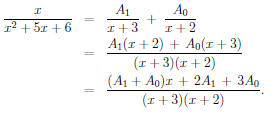Partial Fractions, Long Division
A rational expression is a quotient of polynomials, i.e. has the form

At first sight, rational expressions are difficult to integrate. However, the
algebraic techniques of partial fraction expansion and long division can be used
to make these complex expressions simpler.
1.1 Partial fraction expansion
Word of Warning: Our method here applies when the denominator has linear,
nonrepeated factors only. This will be sufficient for our Calc II class, but
some
of you will see more sophisticated methods in other classes.
Partial fractionsworks when the largest power of the numerator is smaller
than the largest power of the denominator. Here are the instructions. Start
with a rational expression:

First, completely factor the bottom polynomial:

Second, break up the fraction so that the factors of the bottom become
the
denominators of individual fractions, with (as of yet) unknown constants in
the numerators:

Third, figure out what the constants
 are.
are.
Example 1 Use partial fraction expansion to simplify

Solution We simply follow the instructions laid out above:
First, factor the bottom:

Second, break up the fraction

Third, figure out what A1 and A0 are:

Thus x = (A1 +A0)x + 2A1 + 3A0, so that A1 +A0 = 1 and 2A1 +3A0 = 0.
We can solve these two equations, to get A1 = 3, A0 = -2. Thus
finally

Example 2 Evaluate

Solution The fraction is too tough to evaluate, so we have to use
partial fraction
expansion to simplify it.

Thus A1 + A0 = 2 and -3A1
- 4A0 = -1. We can solve this to get A1 = 7,
A0 = -5. Therefore

Now we can solve our calculus problem:

1.2 Long Division
Long division (or synthetic division) can be used when the highest power on
top is equal to or larger than the highest power on bottom.
Example 3 Evaluate

Solution The fraction is too tough to evaluate directly. Since the top power
is
bigger, we have to use long division. Using the long division process (which
we discussed in class), we get

Note: you can also use synthetic division to arrive at this conclusion. Now
we
can solve our calculus problem:



